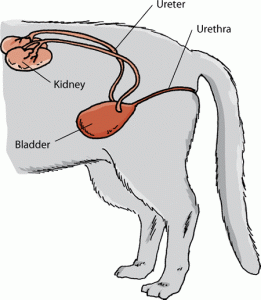 Urinary system disorders are very common in dogs and cats. The urinary system consists of two kidneys, two ureters, a bladder, two sphincter muscles, and a urethra. The bladder is a sensitive organ whose main function is to eliminate waste. Problems include urinary tract infections, bladder stones, bladder infections (cystitis), spraying, and incontinence. Cats are often diagnosed with Feline Urologic Syndrome, which is really a catch-all phrase for such problems.
Urinary system disorders are very common in dogs and cats. The urinary system consists of two kidneys, two ureters, a bladder, two sphincter muscles, and a urethra. The bladder is a sensitive organ whose main function is to eliminate waste. Problems include urinary tract infections, bladder stones, bladder infections (cystitis), spraying, and incontinence. Cats are often diagnosed with Feline Urologic Syndrome, which is really a catch-all phrase for such problems.
Symptoms of urinary tract infections and cystitis include increased frequency of urination with little output, and pain and discomfort while trying to urinate. There also may be blood in the urine, or your pet’s bladder may be bloated and hard.
If a urinary tract problem is not dealt with, infection may spread to the kidneys. You do not want the problem to get this severe because damaged kidneys are damaged forever. 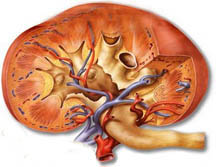 The tissues don’t regenerate. See the kidney section for more information.
The tissues don’t regenerate. See the kidney section for more information.
Bladder stones or gravel in the urinary tract are common in older dogs and cats. If your pet strains to urinate but nothing comes out, stones may be in the way. This is caused when your pet’s pH is off. An overly alkaline system will cause urinary salts to crystalize. Because commercial pet foods caused a drastic increase in pet urinary tract problems, particularly with cats, pet food manufacturers came out with cat foods that are marketed for “urinary tract health.” These foods counteract the pH problem with acidic additives. This is not an optimal solution, however, because the use of these acidic formulations leaches calcium out of your pet’s bones and causes other problems.
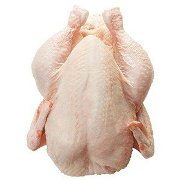 The best preventative is to feed your pet a proper, well-balanced raw diet – the kind of food canine and feline ancestors evolved on. With cats, it’s important to not leave food out as a constant grazing source. Letting a cat’s natural hunger build up keeps their system acidic, as it’s supposed to be. As carnivores, cats are meant to eat no more than twice a day. The interim fasting regulates proper pH levels. At each meal, leave food out no longer than thirty minutes.
The best preventative is to feed your pet a proper, well-balanced raw diet – the kind of food canine and feline ancestors evolved on. With cats, it’s important to not leave food out as a constant grazing source. Letting a cat’s natural hunger build up keeps their system acidic, as it’s supposed to be. As carnivores, cats are meant to eat no more than twice a day. The interim fasting regulates proper pH levels. At each meal, leave food out no longer than thirty minutes.
It’s also important to make sure your dog or cat has outdoor breaks every few hours so that they don’t try to hold their urine in too long. Give plenty of fresh, clean water and see that your pet gets adequate exercise.
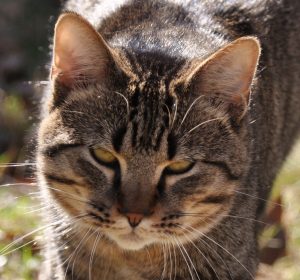 Put multiple litter boxes around the house for your cat. Make sure that you are cleaning the litter boxes every day. We do not approve of the clumpable litters that are popular nowadays. People tend to just scoop out the lumps and leave a lot of bacteria behind, in the sand, to fester for days, weeks, even months.
Put multiple litter boxes around the house for your cat. Make sure that you are cleaning the litter boxes every day. We do not approve of the clumpable litters that are popular nowadays. People tend to just scoop out the lumps and leave a lot of bacteria behind, in the sand, to fester for days, weeks, even months.
The litter box method we use is one we picked up at veterinary hospitals. Instead of filling a large pan full of litter and either changing it each day or just taking out the lumps, place some newspaper or a liner in the clean pan, and then put a sifting of litter on top. Each time your cat defecates, grab up the whole mess in a bundle, and replace it with new paper and new litter. This method is very easy, very clean, and very efficient.
Keeping a sanitary litter box is pertinent to this section because a cat may have developed a habit of holding in its urine if the litter box frequently stinks. Remember, too, that a cat’s nose is far more sensitive than yours. The same can happen with dogs who aren’t let out enough.
Spraying is a territorial gesture and is more common in intact males. Some cases of spraying and defecating in undesirable areas are behavioral issues. See the sections on behavior problems and neutering for more information. Don’t assume, however, that spraying or urinating outside the litter box is a behavioral problem. It could be due to a urinary system disorder. Incontinence is discussed at the bottom of this page.
Herbal and Naturopathic Help
Improving your pet’s diet is the best thing you can do with any urinary system disorder. If you don’t, and your pet eats a commercial pet food, the problem is sure to recur. See the diet section for more information. See a holistic veterinarian. He or she will probably recommend a fast.
Vitamin C is often recommended, not only for its antioxidant properties which help to speed up the healing process, but also because it will help maintain acidic urine. This is beneficial if stones or gravel are a problem. Extra vitamins E and A are also helpful, but don’t overdose your pet on these fat-soluble vitamins. . Per ten pounds of body weight, give 5 IUs of Vitamin E and a couple of drops of fish oil. See Dosage Guidelines. As always, it’s best to consult with a holistic veterinarian. A good multi-vita-mineral is also a wise idea because the right proportions of B-complex, calcium, and magnesium play a role in urinary system health. Bones provide an optimum caclium/phophorus balance.
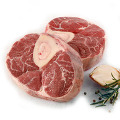 Most veterinarians will prescribe antibiotics for a urinary tract or bladder infection. Some naturopaths don’t believe these are necessary in many cases. It’s important that you consult with a holistic veterinarian. Sometimes antibiotics are necessary, and you don’t want the kidneys to be affected. The key to future health is that you also treat the underlying problem, so that the infections don’t keep recurring. Frequent use of antibiotics will weaken your pet’s immune system, which is vital for staving off all disease.
Most veterinarians will prescribe antibiotics for a urinary tract or bladder infection. Some naturopaths don’t believe these are necessary in many cases. It’s important that you consult with a holistic veterinarian. Sometimes antibiotics are necessary, and you don’t want the kidneys to be affected. The key to future health is that you also treat the underlying problem, so that the infections don’t keep recurring. Frequent use of antibiotics will weaken your pet’s immune system, which is vital for staving off all disease.
The herbs Galium aperine (cleavers), Arctostaphylos uva ursi (bearberry), and Berberis vulgaris (barberry) have antibacterial and antiseptic properties which are good for the treatment of urinary tract infections, and for overall support of the urinary system. Cranberry also helps. In addition, these herbs reduce inflammation and strengthen the immune system.
 For dogs with urinary tract or bladder stones, Thlapsi bursa (shepherd’s purse or Capsella) can be helpful. For small stones and gravel in the urine, sarsaparilla (Smilax officinalis) is often given. And shave grass or horsetail grass have been recommended for cats who urinate a lot or urinate outside the litter box. Remember that the most common cause of the latter, however, is an unsanitary litter box.
For dogs with urinary tract or bladder stones, Thlapsi bursa (shepherd’s purse or Capsella) can be helpful. For small stones and gravel in the urine, sarsaparilla (Smilax officinalis) is often given. And shave grass or horsetail grass have been recommended for cats who urinate a lot or urinate outside the litter box. Remember that the most common cause of the latter, however, is an unsanitary litter box.
Again, we stress the importance of taking your pet to a holistic veterinarian if you suspect a urinary tract problem. Stones and infections can be serious.
Homeopathy
There are many homeopathic treatments for urinary system disorders. Consult with a veterinarian who has expertise in homeopathy. Don’t try to treat these problems on your own.
For cats who are experiencing difficult and painful urination, possibly with blood, Belladonna 30c given once every thirty minutes for a total of two treatments is a good start.
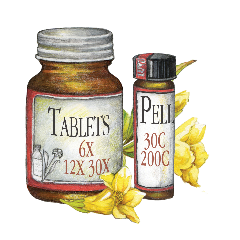 For dogs or cats who are withdrawn and irritable, give Nux vomica 30c every thirty minutes for a total of two treatments.
For dogs or cats who are withdrawn and irritable, give Nux vomica 30c every thirty minutes for a total of two treatments.
For dogs or cats who have become quiet and unusually affectionate, give Pulsatilla 30c every thirty minutes for a total of two treatments. This is also indicated for cats who are avoiding heat.
For cats who are very angry and upset, possibly growling due to their frustrating attempts to urinate, give Cantharis 30c every thirty minutes for a total of two treatments. The cat may also be licking furiously at its genital area. If the cat has these symptoms and has also had prior mouth problems with inflamed gums, give Mercurius vivus 30c every four hours for a total of three treatments.
For urinary tract blockage when the above treatments have not helped, give Coccus cacti 30c every thirty minutes for a total of two treatments.
If your veterinarian prescribes a catheter, Staphysagris (stavesacre) 30c every four hours for three treatments may be helpful with recovery.
Once symptoms have abated, your homeopathic veterinarian may want you to give one dose of Calcarea carbonica 30c to help remove grit and sludge from the urinary tract. Do not repeat this treatment.
Thuya (or Thuja), Silicea, and Urtica urens are sometimes used on a schedule to prevent stones. Consult a homeopathic veterinarian.
Incontinence
Urinary incontinence is the involuntary passing or leaking of urine. The dog or cat is not deliberately urinating, the urine just dribbles out. Roughly one in five dogs will develop this problem, usually older females, but not always. It occurs less frequently in cats. Territorial marking and spraying, frequent urination, and submissive or excited piddling are not considered incontinence.
 A weak bladder sphincter is the most common cause of incontinence. Other causes can include urethral valves that are not working properly, urinary system defects, cancer, or prostate problems in male pets. Spayed females are most susceptible due to low estrogen levels, along with other factors, and can be affected at any age after spaying. Male dogs can develop a weakened sphincter as well, usually in later years.
A weak bladder sphincter is the most common cause of incontinence. Other causes can include urethral valves that are not working properly, urinary system defects, cancer, or prostate problems in male pets. Spayed females are most susceptible due to low estrogen levels, along with other factors, and can be affected at any age after spaying. Male dogs can develop a weakened sphincter as well, usually in later years.
Typical incontinence problems are conventionally treated with synthetic hormones. If you are looking for a more natural method, there are some alternative treatments you can try. Homeopathics include Causticum, Gelsemium sempervirens, and Turnera diffusa. The specific cause of the problem should be properly diagnosed to determine the best course of treatment, so see a holistic veterinarian before trying to treat this yourself. Remember, this is a condition that your pet has no control over, and he or she should not be punished for wetting the bed at night. Your pet is no more happy about it than you are.
The products Simplex F and Vasculin may also be helpful. Simplex F contains glandular extracts and nucleoprotein-minerals which support the healthy function of the ovaries and the adrenal, pituitary, and thyroid glands. Because incontinence is often caused by insufficient hormone production, glandular supports are recommended. Vasculin is used for muscle and nervous system support. These supplements can be used separately or together, depending on the case. Give one tablet per ten pounds of body weight, and follow the directions accordingly.
 There are things you can do to help make your pet’s incontinence situation a little better. You may think that giving your pet less to drink is a good idea, but the opposite is actually true. You want to tone and nourish the urinary tract, so giving plenty of fresh water, and supplementing the diet with diuretic herbs can help. Marshmallow (the herb), cleavers, cornsilk, and horstail are examples of diuretic botanicals.
There are things you can do to help make your pet’s incontinence situation a little better. You may think that giving your pet less to drink is a good idea, but the opposite is actually true. You want to tone and nourish the urinary tract, so giving plenty of fresh water, and supplementing the diet with diuretic herbs can help. Marshmallow (the herb), cleavers, cornsilk, and horstail are examples of diuretic botanicals.
Feed your pet a natural diet. Take your dog out to pee frequently, or provide access via a doggie door. Schedule a pee time right before you go to sleep, and as soon as you wake up in the morning. Keep your cat’s litter box clean using the shallow pan and liner method described above, and use multiple litter boxes around the house. Change your pet’s bedding daily. If you want your dog or cat to keep its favorite cushion or pillow, wrap the cushion in heavy plastic and then cover that with bedding that you can easily wash. This will help to cut down on smell and potential health risks.